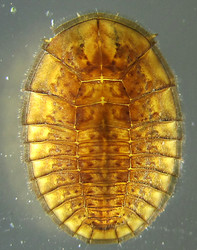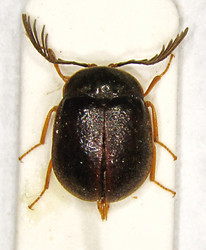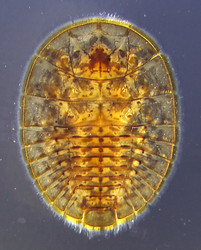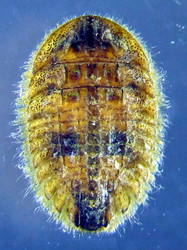Psephenidae
Water penny beetles
William Shepard


This tree diagram shows the relationships between several groups of organisms.
The root of the current tree connects the organisms featured in this tree to their containing group and the rest of the Tree of Life. The basal branching point in the tree represents the ancestor of the other groups in the tree. This ancestor diversified over time into several descendent subgroups, which are represented as internal nodes and terminal taxa to the right.

You can click on the root to travel down the Tree of Life all the way to the root of all Life, and you can click on the names of descendent subgroups to travel up the Tree of Life all the way to individual species.
For more information on ToL tree formatting, please see Interpreting the Tree or Classification. To learn more about phylogenetic trees, please visit our Phylogenetic Biology pages.
close boxIntroduction
Psephenidae contains 5 subfamilies: Afroeubriinae, Eubrianacinae, Eubriinae, Psepheninae and Psephenoidinae; with about 35 genera and 275 species. However, there are many species and some genera that are known but as yet undescribed. The range of the family includes all continents, except Antarctica, and many islands. The common names are derived from the larvae, some of which are similar in size, shape and color to the penny coin. Earlier classifications put some subfamilies into other beetle families or considered them as distinct families. Diversity is low in the Nearctic and Palearctic regions, and particularly high in the Oriental and Neotropical regions. The Ethiopean region remains poorly examined for psephenids (Shepard and Lee 2007).
The short-lived adults usually are found near the streams and rivers in which their larvae live, although some live in wave-swept lake margins (Murvosh 1992). Adults can be collected from partially submerged rocks and vegetation overhanging the water. Adult eubriines and psephenoidines readily come to lights at night. Oviposition is on submerged objects (Murvosh 1971). Larvae go through several stadia before pupation. Most pupation is under rocks and in grassy clumps along stream margins, although submerged pupation occurs in Psephenoidinae and occasionally in Eubriinae and Psepheninae (Murvosh and Brown 1977).
Characteristics
Psephenidae is a morphologically diverse group of taxa. Unlike other beetle families there are very good descriptions for larvae, pupae and adults. The best analysis of psephenid characters is in Lee et al. (2007).


Eubrianax edwardsii, adult © 2011 Susan McCormick
Adults can be recognized by the following characters:
- Soft bodies and elytra
- Serrate to pectinate antennae (sexually dimprphic in many species)
- Posterior pronotal margins and anterior elytral and scutellar margins often crenulate
- Elytra may not always fit together
- Elytra often with tubercles in lines or networks
- Anterior coxae with exposed trochantin
- Abdomen with 5-7 sternites
- Male genitalia complex, with many membraneous areas
- Stream associations


Eubrianax edwardsii, larva (dorsal view) © 2011 Susan McCormick
Larvae can be recognized by the following characters.
- Onisciform body shape
- Expanded lateral margins in thoracic and abdominal segments
- Head hidden dorsally
- Tracheal gills either exposed on several abdominal sternites (Eubrianacinae, Psepheninae) or hidden under a ventral, terminal operculum (Afroeubriinae, Eubriinae, Psephenoidinae)
Discussion of Phylogenetic Relationships
Considerable confusion has resulted from morphological variation within the family and the misassociation of larvae and adults. Early attempts at understanding relationships within Psephenidae and between Psephenidae and related families are in Hinton (1939, 1955, 1966), Bertrand (1972), Crowson (1960, 1978), Lawrence (1987) and Beutel (1995).
Two more recent studies have provided some stability for and within Psephenidae. Costa et al. (1998) examined relationships within Elateriformia including the aquatic families of Byrrhoidea. They found Psephenidae to be a sister group to Cneoglossidae. The Psephenidae branch had Eubriinae as a basal group followed by a trichotomy for the other subfamilies. Lee et al. (2007) examined the relationships of subfamilies and most genera within Psephenidae resulting in the cladogram given above. Several new genera have been described since then that may produce additional changes.
Paleontology
So far the only unquestionable psephenid fossils have been larvae of Eubrianacinae from the Palearctic Cenozoic (Bertrand et Laurentiaux 1963; Schmied et al. 2008; Hayashi and Kawakami 2009) and of Psepheninae (Mateopsephus) from the Early Pleistocene of Japan (Fujiyama 1983).
Other Names for Psephenidae
- Psephenoidea
- Eubriidae
- Vernacular Names: Water penny beetles, false water penny beetles
References
Arce-Pérez, R. y W. D. Shepard. 2001. Sinopsis de la familia Psephenidae (Coleoptera: Dryopoidea) de Norte y Centroamérica. Folia Entomologia Mexicana, 40(3): 397-406.
Bertrand, H. 1972. Larves et Nymphes des Coléoptères Aquatiques du Globe. F. Paillart, Paris. 285 pp.
Bertrand, H. et D. Laurentiaux. 1963. Une larve “Pséphenoïde” du genere Eubrianax dans l’ Eocène lacustre de l’ Aude. Bulletin de Societe d’ Histoire naturelle de Toulouse, 98: 232-241.
Beutel, R. G. 1995. Phylogenetic analysis of Elateriformia (Coleoptera: Polyphaga) based on larval characters. Journal of Zoological Systematics and Evolutionary Research, 33: 145-171.
Brown, H. P. 1983. A Catalog of the Coleoptera of America North of Mexico. Family: Psephenidae. United States Department of Agriculture. Agriculture Handbook NO. 529-49. 8 pp.
Costa, C., S. A. Vanin, and S. Ide. 1999. Systematics and bionomics of Cneoglossidae with a cladistic analysis of Byrrhoidea sensu Lawrence and Newton (1995) (Coleoptera, Elateriformia). Arquivos de Zoologia, 35(3): 231-300.
Crowson, R. A. 1960. The phylogeny of Coleoptera. Annual Review of Entomology, 5: 231-300.
Crowson, R. A. 1978. Problems of phylogenetic relationships in Dryopoidea (Coleoptera). Entomologica Generalis, 4: 250-257.
Fujiyama, I. 1983. A fossil water penny from an Early Pleistocene bed in Japan (Coleoptera, Psephenidae). Special Issue Concerning the Aquatic Coleoptera Presented at the Workshop of the XVI International Congress of Entomology in Kyoto, Japan in 1980, 1983: 21-26.
Hayashi, M. and Y. Kawakami. 2009. Fossil of the genus Eubrianax (Coleoptera, Psephenidae) from the Upper Miocene Ningyôtôge formation in Tottori Prefecture, Japan. Elytra, Tokyo, 37(1): 99-103.
Hinton, H. E. 1939. An inquiry into the natural classification of the Dryopoidea, based partly on a study of their internal anatomy (Col.). Transactions of the Royal Entomological Society of London, 89: 133-184.
Hinton, H. E. 1955. On the respiratory adaptations, biology, and taxonomy of the Psephenidae, with notes on some related families (Coleoptera). Proceedings of the Zoological Society of London, 135: 543-568.
Hinton, H. E. 1966. Respiratory adaptations of the pupa of beetles of the family Psephenidae. Philosophical Transactions of the Royal Society of London, Series B, 251: 211-245.
Lawrence, J. F. 1987. Rhinorhipidae, a new beetle family from Australia, with comments on the phylogeny of the Elateriformia. Invertebrate Taxonomy, 2: 1-53.
Lee, C.-F., M. A. Jäch and R. G. Beutel. 2005. 18.7 Psephenidae Lacordaire, 1854. Pages 521-533. In: R. G. Beutel, R. A. B. Leschen, eds.). Handbook of Zoology. Volume IV, Part 38. Coleoptera, Beetles. Volume 1: Morphology and Systematics (Archostemata, Adephaga, Myxophaga, Polyphaga partim). Walter de Gruyter. Berlin. 567 pp.
Lee, C.-F., M. Satô, W. D. Shepard, M. A. Jäch. 2007. Phylogeny of Psephenidae (Coleoptera: Byrrhoidea) based on larval, pupal and adult characters. Systematic Entomology, 32: 502-538.
Murvosh, C. M. 1971. Ecology of the water penny beetle Psephenus herricki (DeKay). Ecological Monographs, 41: 79-96.
Murvosh, C. M. 1992. On the occurrence of the water penny beetle Eubrianax edwardsii in lentic ecosystems (Coleoptera: Psephenidae). The Coleopterists Bulletin, 46(1): 43-51.
Murvosh, C. M. and H. P. Brown. 1977. Mating behavior of water penny beetles (Coleoptera: Psephenidae): a hypothesis. The Coleopterists Bulletin, 30(1): 57-59.
Schmied, H., S. Wedmann und T. Hörnschemeyer. 2008. Wasserpfennige aus dem Mittel-Eozän de Grube Messel – morphologie, ökologie und systematic. Deutsche Gesellschaft für allgemeine und angewandte Entomologie Nachrichten, 22(1): 16-17.
Shepard, W. D. 2002. Family 48. Psephenidae Lacordiare 1854. Pages 133-134. In: (R. H. Arnett, Jr., M. C. Thomas, P. E. Skelley and J. H. Frank, eds.). American Beetles. Volume 2. Polyphaga: Scarabaeoidea through Curculionoidea. CRC Press. Boca Raton, Florida. 861 pp.
Shepard, W. D. and C.-F. Lee. 2007. Chapter 19: Psephenidae. Pages 167-172. In: (R. Stals & I. J. de Moor, eds.) Guides to the Freshwater Invertebrates of Southern Africa. Volume 10: Coleoptera. Water Research Commission. Pretoria, South Africa. 263 pp.
Information on the Internet
- Psephenidae at Bugguide.net
Title Illustrations

| Scientific Name | Schinostethus sp. |
|---|---|
| Specimen Condition | Dead Specimen |
| Identified By | William Shepard |
| Life Cycle Stage | adult |
| View | dorsal |
| Copyright | © 2011 Susan McCormick |
| Scientific Name | Psephenops sp. |
|---|---|
| Specimen Condition | Dead Specimen |
| Identified By | William Shepard |
| Life Cycle Stage | larva |
| View | dorsal |
| Copyright | © Susan McCormick |
About This Page

Univerrsity of California, Berkeley
Correspondence regarding this page should be directed to William Shepard at
Page copyright © 2011
 Page: Tree of Life
Psephenidae. Water penny beetles.
Authored by
William Shepard.
The TEXT of this page is licensed under the
Creative Commons Attribution-NonCommercial License - Version 3.0. Note that images and other media
featured on this page are each governed by their own license, and they may or may not be available
for reuse. Click on an image or a media link to access the media data window, which provides the
relevant licensing information. For the general terms and conditions of ToL material reuse and
redistribution, please see the Tree of Life Copyright
Policies.
Page: Tree of Life
Psephenidae. Water penny beetles.
Authored by
William Shepard.
The TEXT of this page is licensed under the
Creative Commons Attribution-NonCommercial License - Version 3.0. Note that images and other media
featured on this page are each governed by their own license, and they may or may not be available
for reuse. Click on an image or a media link to access the media data window, which provides the
relevant licensing information. For the general terms and conditions of ToL material reuse and
redistribution, please see the Tree of Life Copyright
Policies.
- First online 05 February 2011
- Content changed 05 February 2011
Citing this page:
Shepard, William. 2011. Psephenidae. Water penny beetles. Version 05 February 2011 (under construction). http://tolweb.org/Psephenidae/9122/2011.02.05 in The Tree of Life Web Project, http://tolweb.org/












 Go to quick links
Go to quick search
Go to navigation for this section of the ToL site
Go to detailed links for the ToL site
Go to quick links
Go to quick search
Go to navigation for this section of the ToL site
Go to detailed links for the ToL site